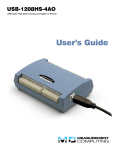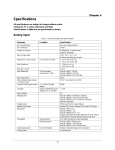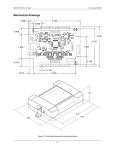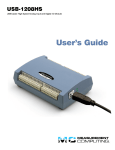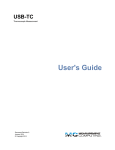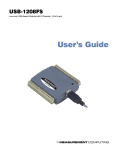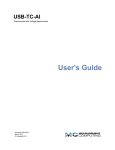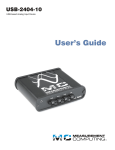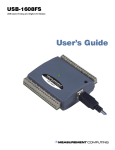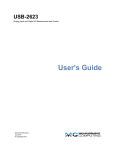Download USB-1208HS-4AO User's Guide - from Measurement Computing
Transcript
USB-1208HS-4AO High-Speed Analog Input and Digital I/O User's Guide Document Revision 4 July 2014 © Copyright 2014 Your new Measurement Computing product comes with a fantastic extra — Management committed to your satisfaction! Thank you for choosing a Measurement Computing product—and congratulations! You own the finest, and you can now enjoy the protection of the most comprehensive warranties and unmatched phone tech support. It’s the embodiment of our mission: To provide data acquisition hardware and software that will save time and save money. Simple installations minimize the time between setting up your system and actually making measurements. We offer quick and simple access to outstanding live FREE technical support to help integrate MCC products into a DAQ system. Limited Lifetime Warranty: Most MCC products are covered by a limited lifetime warranty against defects in materials or workmanship for the life of the product, to the original purchaser, unless otherwise noted. Any products found to be defective in material or workmanship will be repaired, replaced with same or similar device, or refunded at MCC’s discretion. For specific information, please refer to the terms and conditions of sale. Harsh Environment Program: Any Measurement Computing product that is damaged due to misuse, or any reason, may be eligible for replacement with the same or similar device for 50% of the current list price. I/O boards face some harsh environments, some harsher than the boards are designed to withstand. Contact MCC to determine your product’s eligibility for this program. 30 Day Money-Back Guarantee: Any Measurement Computing Corporation product may be returned within 30 days of purchase for a full refund of the price paid for the product being returned. If you are not satisfied, or chose the wrong product by mistake, you do not have to keep it. These warranties are in lieu of all other warranties, expressed or implied, including any implied warranty of merchantability or fitness for a particular application. The remedies provided herein are the buyer’s sole and exclusive remedies. Neither Measurement Computing Corporation, nor its employees shall be liable for any direct or indirect, special, incidental or consequential damage arising from the use of its products, even if Measurement Computing Corporation has been notified in advance of the possibility of such damages. Trademark and Copyright Information Measurement Computing Corporation, InstaCal, Universal Library, and the Measurement Computing logo are either trademarks or registered trademarks of Measurement Computing Corporation. Refer to the Copyrights & Trademarks section on mccdaq.com/legal for more information about Measurement Computing trademarks. Other product and company names mentioned herein are trademarks or trade names of their respective companies. © 2014 Measurement Computing Corporation. All rights reserved. No part of this publication may be reproduced, stored in a retrieval system, or transmitted, in any form by any means, electronic, mechanical, by photocopying, recording, or otherwise without the prior written permission of Measurement Computing Corporation. Notice Measurement Computing Corporation does not authorize any Measurement Computing Corporation product for use in life support systems and/or devices without prior written consent from Measurement Computing Corporation. Life support devices/systems are devices or systems that, a) are intended for surgical implantation into the body, or b) support or sustain life and whose failure to perform can be reasonably expected to result in injury. Measurement Computing Corporation products are not designed with the components required, and are not subject to the testing required to ensure a level of reliability suitable for the treatment and diagnosis of people. HM USB-1208HS-4AO.docx 2 Table of Contents Preface About this Manual ................................................................................................................................. 5 Conventions ........................................................................................................................................................ 5 Where to find more information ......................................................................................................................... 5 Chapter 1 Introducing the USB-1208HS-4AO ...................................................................................................... 6 Functional block diagram ................................................................................................................................... 6 Chapter 2 Installing the USB-1208HS-4AO .......................................................................................................... 7 What comes with your shipment? ....................................................................................................................... 7 Hardware .......................................................................................................................................................................... 7 Software ............................................................................................................................................................................ 7 Documentation .................................................................................................................................................................. 7 Unpacking........................................................................................................................................................... 7 Installing the software ........................................................................................................................................ 7 Installing the hardware ....................................................................................................................................... 7 Calibrating the USB-1208HS-4AO .................................................................................................................... 8 Chapter 3 Functional Details ................................................................................................................................. 9 Analog input acquisition modes ......................................................................................................................... 9 Software paced mode ........................................................................................................................................................ 9 Hardware paced mode....................................................................................................................................................... 9 External components .......................................................................................................................................... 9 Screw terminals................................................................................................................................................................10 USB connector .................................................................................................................................................................11 Activity LED ...................................................................................................................................................................11 Status LED .......................................................................................................................................................................11 Signal connections ............................................................................................................................................ 11 Analog input ....................................................................................................................................................................11 Analog output ..................................................................................................................................................................12 External clock I/O ............................................................................................................................................................12 Digital I/O ........................................................................................................................................................................13 Counter input ...................................................................................................................................................................14 Timer output ....................................................................................................................................................................14 Trigger input ....................................................................................................................................................................15 Power output ....................................................................................................................................................................15 Ground .............................................................................................................................................................................15 Chapter 4 Specifications ...................................................................................................................................... 16 Analog input ..................................................................................................................................................... 16 Analog output ................................................................................................................................................... 18 Digital input/output........................................................................................................................................... 18 External trigger ................................................................................................................................................. 19 External clock input/output............................................................................................................................... 19 Counters ............................................................................................................................................................ 20 Timer ................................................................................................................................................................ 20 Memory ............................................................................................................................................................ 20 Power ................................................................................................................................................................ 21 USB specifications ........................................................................................................................................... 21 3 USB-1208HS-4AO User's Guide Environmental .................................................................................................................................................. 21 Mechanical ....................................................................................................................................................... 22 Screw terminal connector and pinout ............................................................................................................... 22 Declaration of Conformity .................................................................................................................. 24 4 Preface About this Manual This document describes the USB-1208HS-4AO data acquisition device and lists device specifications. Conventions For more information Text presented in a box signifies additional information related to the subject matter. Caution! Shaded caution statements present information to help you avoid injuring yourself and others, damaging your hardware, or losing your data. bold text Bold text is used for the names of objects on a screen, such as buttons, text boxes, and check boxes. italic text Italic text is used for the names of manuals and help topic titles, and to emphasize a word or phrase. Where to find more information Additional information about USB-1208HS-4AO hardware is available on our website at www.mccdaq.com. You can also contact Measurement Computing Corporation by phone, fax, or email with specific questions. Knowledgebase: kb.mccdaq.com Phone: 508-946-5100 and follow the instructions for reaching Tech Support Fax: 508-946-9500 to the attention of Tech Support Email: [email protected] 5 Chapter 1 Introducing the USB-1208HS-4AO The USB-1208HS-4AO is a high-speed analog input and digital I/O data acquisition device providing the following features: Eight 13-bit single-ended (SE) or four differential (DIFF) analog inputs Four 12-bit analog outputs One external clock input and one external output for analog inputs One external clock input and one external output for analog outputs One digital trigger input 16 individually configurable digital I/O channels Two 32-bit counter inputs One 32-bit timer output Screw terminals for field wiring connections The device is powered by the +5 volt USB supply from your computer, and requires no external power. The USB-1208HS-4AO is a USB 2.0 high-speed device supported under popular Microsoft® Windows® operating systems. The USB-1208HS-4AO is compatible with both USB 1.1 and USB 2.0 ports (although the speed of the module maybe limited when using USB 1.1 ports). Functional block diagram USB-1208HS-4AO functions are illustrated in Figure 1. Figure 1. USB-1208HS-4AO functional block diagram 6 Chapter 2 Installing the USB-1208HS-4AO What comes with your shipment? The following items are shipped with the USB-1208HS-4AO: Hardware USB-1208HS-4AO USB cable Software MCC DAQ CD Documentation In addition to this hardware user's guide, you should also receive the Quick Start Guide. This booklet provides an overview of the MCC DAQ software you received with the device, and includes information about installing the software. Please read this booklet completely before installing any software or hardware. Unpacking As with any electronic device, take care while handling to avoid damage from static electricity. Before removing the USB-1208HS-4AO from its packaging, ground yourself using a wrist strap or touch either the computer chassis or other grounded object to eliminate any stored static charge. If the device is damaged, notify Measurement Computing Corporation immediately by phone, fax, or email. Knowledgebase: kb.mccdaq.com Phone: 508-946-5100 and follow the instructions for reaching Tech Support Fax: 508-946-9500 to the attention of Tech Support Email: [email protected] For international customers, contact your local distributor. Refer to the International Distributors section on our web site at www.mccdaq.com/International. Installing the software Refer to the Quick Start Guide for instructions on installing the software on the MCC DAQ CD. This booklet is available in PDF at www.mccdaq.com/PDFmanuals/DAQ-Software-Quick-Start.pdf. Installing the hardware Be sure you are using the latest system software Before you install the device, run Windows Update to update your operating system with the latest USB drivers. Install the MCC DAQ software before you install your board The driver needed to run your board is installed with the MCC DAQ software. Therefore, you need to install the software before you install your board. Refer to the Quick Start Guide for instructions. To connect the USB-1208HS-4AO to your system, turn your computer on, and connect the USB cable to a USB port on your computer or to an external USB hub connected to your computer. The USB cable provides power and communication to the USB-1208HS-4AO. When you connect the USB-1208HS-4AO for the first time, a Found New Hardware dialog opens when the operating system detects the device. The Status LED turns on; this indicates that communication is established between the device and the computer. Refer to Figure 2 on page 9 for the location of the Status LED. When the dialog closes, the installation is complete. 7 USB-1208HS-4AO User's Guide Installing the USB-1208HS-4AO Caution! Do not disconnect any device from the USB bus while the computer is communicating with the device, or you may lose data and/or your ability to communicate with the USB-1208HS-4AO.. If the Status LED turns off The Status LED turns off if communication is lost between the device and the computer. To restore communication, disconnect the USB cable from the computer and reconnect it. The Status LED should turn on. Calibrating the USB-1208HS-4AO The USB-1208HS-4AO is shipped fully calibrated. Calibration coefficients are stored in EEPROM. Return the device to Measurement Computing Corporation when calibration is required. The normal calibration interval is once per year. 8 Chapter 3 Functional Details Analog input acquisition modes The USB-1208HS-4AO can acquire analog input data in two basic modes – software paced and hardware paced. Software paced mode You can acquire one analog sample at a time in software paced mode. You initiate the A/D conversion by calling a software command. The analog value is converted to digital data and returned to the computer. You can repeat this procedure until you have the total number of samples that you want. The throughput sample rate in software paced mode is system-dependent, and can range from 33 S/s to 4000 S/s. Hardware paced mode You can acquire data from up to eight channels in hardware-paced mode. The analog data is continuously acquired, converted to digital values, and written to an onboard FIFO buffer on the device until you stop the scan. The FIFO buffer is serviced in blocks as the data is transferred from the USB-1208HS-4AO FIFO buffer to the memory buffer on your computer. The maximum sampling rate is 1 MS/s aggregate over one-to-eight channels. You can start a continuous scan with either a software command or with an external hardware trigger event. External components The USB-1208HS-4AO has the following external components, as shown in Figure 2. Screw terminal banks LED indicators USB connector 1 2 3 Screw terminal pins 1 to 28 Screw terminal pins 29 to 56 Status LED 4 5 Activity LED USB connector Figure 2. External components 9 USB-1208HS-4AO User's Guide Functional Details Screw terminals The differential mode pinout is shown in Figure 3. Figure 3. Differential mode pinout The single-ended mode pinout is shown in Figure 4. Figure 4. Single-ended mode pinout Use 16 AWG to 30 AWG for signal connections. 10 USB-1208HS-4AO User's Guide Functional Details USB connector The USB connector provides +5 V power and communication. No external power supply is required. Activity LED The Activity LED indicates the communication status of the USB-1208HS-4AO. It blinks when data is transferred, and is off when the device is not communicating. This LED uses up to 10 mA of current and cannot be disabled. Status LED The Status LED turns on when the device is detected and installed on the computer. Signal connections Analog input You can connect up to eight analog input connections to the screw terminals labeled AIN0 through AIN7. Analog signals are referenced to analog ground (AGND). Single-ended mode requires two wires: The wire carrying the signal to be measured connects to AINx. The second wire connects to AGND. Differential mode requires two wires plus a ground reference: The wire carrying the positive portion of the differential signal to be measured connects to AINx. The wire carrying the negative portion of the differential signal to be measured connects to AIN(x+1). The analog ground reference wire connects to AGND. The terminal configurations for single-ended and differential modes are shown in the table below. Channel # 0 1 2 3 4 5 6 7 8 single-ended channels configuration 0 Vin+ AIN0 AIN1 AIN2 AIN3 AIN4 AIN5 AIN6 AIN7 Vin– AGND AGND AGND AGND AGND AGND AGND AGND 4 differential channels configuration Vin+ AIN0 AIN2 AIN4 AIN6 - Vin– AIN1 AIN3 AIN5 AIN7 - In single-ended mode, the input voltage ranges are ±10 V, ±5 V, ±2.5 V, 0 to 10 V. In differential mode, the input voltage ranges are ±20 V, ±10 V, and ±5 V. The voltage level on each AINx input is limited to ±14 V 11 USB-1208HS-4AO User's Guide Functional Details Figure 5 depicts a voltage source connected to a USB-1208HS-4AO configured for SE mode. Figure 5. Single-ended measurement connection Figure 6 depicts a Wheatstone bridge signal source connected to a USB-1208HS-4AO configured for DIFF mode. Figure 6. Differential measurement connection For more information on analog signal connections For more information on single-ended inputs, refer to the Guide to DAQ Signal Connections (this document is available on our web site at www.mccdaq.com/signals/signals.pdf). Analog output You can connect up to four analog output connections to screw terminals AOUT0 to AOUT3. Refer to Figure 4 and Figure 3 on page 10 for the location of these pins. Each channel can be software-paced at rates up to 5,000 updates per second (system-dependent), or hardwarepaced at rates up to 1 MS/s. Each analog output on the USB-1208HS-4AO has a fixed ±10 V output range. The outputs default to 0 V at power up. External clock I/O The USB-1208HS-4AO device provides one external clock input (AICKI) and one external clock output (AICKO) for analog inputs, and one external clock input (AOCKI) and one external clock output (AOCKO) for analog outputs. 12 USB-1208HS-4AO User's Guide Functional Details You can connect an external clock signal to AICKI and/or AOCKI. When using an external clock, AICKO outputs the pulse generated from AOCKI , and AOCKO outputs the pulse generated from AOCKI When using the internal clock, AICKO outputs the ADC scan clock, and AOCKO outputs the DAC scan clock. Digital I/O You can connect up to 16 digital I/O lines to screw terminals DIO0 through DIO15. The terminals have 47 kΩ resistors that you can configure for pull-up or down using an internal jumper. The default configuration is pull-down. You can use the digital I/O terminals to detect the state of any TTL-level input. Refer to the schematic in Figure 7. If you set the switch to the +5 V input, DIO0 reads TRUE (1). If you move the switch to GND, DIO0 reads FALSE (0). Figure 7. Schematic showing switch detection by digital channel DIO0 Pull-up/down configuration Each of the 16 DIO bits on the USB-1208HS-4AO has a 47 kΩ pull-up/pull-down resistor. To configure these bits for either a +5 V pull-up or a 0 V pull-down option, you must open the USB-1208HS-4AO case to access the three-pin jumper labeled W34. The pull-up/pull-down voltage is common to all of the internal 47 kΩ resistors. To open the case and set the W34 jumper, do the following. 1. Turn over the USB-1208HS-4AO and rest it on its top on a flat, stable surface. 2. Peel off the four rubber feet on the bottom of the module to access the screws. 3. Remove the four screws shown in Figure 8 from the bottom of the device. Figure 8. Location of screws connecting bottom and top sections of case 4. Holding both the top and bottom sections of the module, turn it back over, rest it on the surface, and carefully remove the top section of the case. 5. Set the jumper to either pull-up or pull-down (see Figure 9 and Figure 10). 13 USB-1208HS-4AO User's Guide Functional Details Figure 9. Location of W34 jumper (default pull-down setting shown) Figure 10. Pull-down and pull-up configurations 1. Replace the top section of the case, and then fasten it to the bottom section with the four screws. For more information on digital signal connections For general information regarding digital signal connections and digital I/O techniques, refer to the Guide to DAQ Signal Connections (available on our web site at www.mccdaq.com/signals/signals.pdf). Counter input CTR0 and CTR1 provide connections to each 32-bit counter input channel. Each counter can count frequencies of up to 20 MHz. Timer output Use the TMR terminal to connect to the pulse width modulation (PWM) timer output. You can set the following timer output parameters through software: pulse frequency duty cycle (pulse width divided by the pulse period) number of pulses to generate time delay before starting the timer output after it's enabled resting state of the output (idle high or idle low) The timer can generate a pulse output with a programmable frequency range of 0.00931 Hz up to 20 MHz. 14 USB-1208HS-4AO User's Guide Functional Details Both the period and time delay ranges are 50 ns to 107.4 seconds. Figure 11. USB-1208HS-4AO PWM timer channel Trigger input The TRIG connection is an external digital trigger input. The trigger mode is software selectable for: Level-sensitive or edge-sensitive Rising or falling edge High or low level The default setting at power up is edge sensitive, rising edge. Retrigger The acquisition uses the trigger settings for positive edge/negative edge and level-sensitive/edge-sensitive, but automatically re-arms the trigger after it is activated Power output You can use the two +5V connections to supply power to external devices or circuitry. These terminals can output up to 285 mA. Refer to Figure 4 and Figure 3 on page 10 for the location of this pin. Caution! The +5V terminals are outputs. Do not connect to an external power supply or you may damage the USB-1208HS-4AO and possibly the computer. Ground The analog ground (AGND) connections provide a common ground for all analog I/O channels. The ground (GND) connections provide a common ground for the digital I/O, timer/counter I/O, timer, clock I/O, and the +5 V terminals. 15 Chapter 4 Specifications All specifications are subject to change without notice. Typical for 25 °C unless otherwise specified. Specifications in italic text are guaranteed by design. Analog input Table 1. Analog input specifications Parameter Condition Specification A/D converter Input ranges Software-selectable per channel Number of channels Input configuration Channel gain queue Absolute maximum input voltage Input impedance Input bandwidth (–3 dB) Input leakage current Input capacitance Offset error drift Gain error drift Maximum working voltage (signal + common mode) Sample rate Sample clock source Burst mode Throughput Resolution A/D no missing codes (uncalibrated) CMRR Crosstalk 8 unique consecutive elements CHx IN to GND All input ranges ±20 V ±10 V ±5 V Software paced Scan to PC memory Differential mode Single-ended mode 60hz SE mode, all ranges, 250 kHz input signal Differential mode, all ranges, 250 kHz input signal 16 Analog Devices AD7329 13-bit successive approximation type Differential: ±20 V, ±10 V, ±5 V (The voltage level on each individual AIN input is limited to ±14 V.) SE: ±10 V, ±5 V, ±2.5 V, 0 V to 10 V 4 differential, 8 single-ended Software-selectable Multiplexed Software-selectable range for each channel ±25 V max (power on) ±12 V max (power off) 35 MΩ min 2 MHz typ ±250 nA typ 32 pf typ 5 ppm/°C typ 25 ppm/°C typ ±14 V ±11 V ±5.5 V 1 S/s to 1 MS/s, software programmable Internal A/D clock or AICKI Software-selectable, burst rate = 1µs 33 S/s to 4000 S/s typ, system dependent 1 MS/s max 13 bits 13 bits 12 bits 74 dB typ –62 dB typ –78 dB typ USB-1208HS-4AO User's Guide Specifications Table 2. Calibrated absolute accuracy Range Accuracy (mV) ±20 V (DIFF mode) ±10 V (DIFF mode) ±5 V (DIFF mode) ±10 V (SE mode) ±5 V (SE mode) ±2.5 V (SE mode) 0 – 10 V (SE mode) ±9.55 typ, ±13.18 max ±4.59 typ, ±6.23 max ±2.25 typ, ±2.75 max ±5.10 typ, ±8.06 max ±2.63 typ, ±4.03 max ±1.59 typ, ±2.70 max ±3.29 typ, ±5.13 max Table 3 summarizes the noise performance for the USB-1208HS-4AO. Noise distribution is determined by gathering 50 kS with inputs tied to ground at the user connector. Samples are gathered at the maximum specified sample rate of 1 MS/s. Table 3. Noise performance Range Typical counts LSBrms ±20 V (DIFF mode) ±10 V (DIFF mode) ±5 V (DIFF mode) ±10 V (SE mode) ±5 V (SE mode) ±2.5 V (SE mode) 0 – 10 V (SE mode) 3 3 3 5 5 5 5 0.45 0.45 0.45 0.91 0.91 0.91 0.91 Table 4. Input settling time in µs, typical Condition Range ±1 LSB ±4 LSB ±8 LSB + full-scale to –full-scale channel switch, same range to same range ±10 V ±5 V ±2.5 V 0 V to 10 V 1.5 2.1 2.2 2.6 1.1 1.1 1.1 1.1 1.0 1.0 1.0 1.0 17 USB-1208HS-4AO User's Guide Specifications Analog output Table 5. Analog output specifications Parameter D/A converter Number of channels Resolution Output range Output transient D/A update rate Sample clock source Monotonicity Output current Output short-circuit protection Output coupling Power up and reset state Output noise Settling time (to 0.05%) Absolute accuracy Slew rate Offset error drift Gain error drift Condition Specification Calibrated Uncalibrated Host PC is reset, powered on, suspended, or a reset command is issued to device. Software paced Hardware paced Output connect to GND 20 V output step, (RL=5 kΩ, CL=200 pf) Texas Instruments DAC7553 4 independent 12 bits ±10 V ±10.2 V Duration: 3 ms typ Amplitude: 6 V p-p typ 33 to 5000 S/s typ, system dependent 1 MHz max (per channel) Internal D/A clock or AOCKI 12 bits ±3 mA max per channel Unlimited duration (10 mA typ) DC 0V 0.53 mV rms 5 µS max ±0.1% 6.7 V/µs typ 10 ppm/°C typ 65 ppm/°C typ Digital input/output Table 6. Digital I/O specifications Parameter Specification Digital type Number of I/O Configuration Pull-up configuration CMOS 16 Each bit may be configured as input (power on default) or output The port has 47 kΩ resistors configurable as pull-up or pull-down with an internal jumper. The default setting is pull-down. 33 to 8000 port reads/writes or single bit reads/writes per second typ, system dependent. Digital I/O transfer rate (system-paced) Input high voltage Input low voltage Output high voltage Output low voltage Output current 2.0 V min 5.5 V absolute max 0.8 V max –0.5 V absolute min 0 V recommended min 4.4 V min (IOH = –50 µA) 3.76 V min (IOH = –24 mA) 0.1 V max (IOL = 50 µA) 0.44 V max (IOL = 24 mA) ±24 mA max per terminal (refer to Power section for additional information) 18 USB-1208HS-4AO User's Guide Specifications External trigger Table 7. External trigger specifications Parameter Specification Trigger source Trigger mode TRIG input Software-selectable for edge or level sensitive, rising or falling edge, high or low level. Power on default is edge sensitive, rising edge. 1 µs + 1 clock cycle max 100 ns min Schmitt trigger, 33 Ω series resistor and 47 kΩ pull-down to ground 0.4 V to 1.2 V 2.2 V min 5.5 V absolute max 1.5 V max –0.5 V absolute min 0 V recommended min Trigger latency Trigger pulse width Input type Schmitt trigger hysteresis Input high voltage Input low voltage External clock input/output Table 8. External clock I/O specifications Parameter Specification Terminal names Terminal types AICKI, AICKO, AOCKI, AOCKO AxCKI: Input, active on rising edge AxCKO: Output, power on default is 0 V, active on rising edge AxCKI: Receives sampling clock from external source AxCKO: Outputs the internal sampling clock (D/A or A/D clock) or pulse generated from AxCKI when in external clock mode 1 MHz max AxCKI: 400 ns min AxCKO: 400 ns min Schmitt trigger, 33 Ω series resistor, 47 kΩ pull-down to ground 0.4 V to 1.2 V 2.2 V min 5.5 V absolute max 1.5 V max –0.5 V absolute min 0 V recommended min 4.4 V min (IOH = –50 µA) 3.76 V min (IOH = –24 mA) 0.1 V max (IOL = 50 µA) 0.44 V max (IOL = 24 mA) ±24 mA max per terminal (refer to Power section for additional information) Terminal descriptions Input clock rate Clock pulse width Input type Schmitt trigger hysteresis Input high voltage Input low voltage Output high voltage Output low voltage Output current 19 USB-1208HS-4AO User's Guide Specifications Counters Table 9. Counter specifications Parameter Specification Counter terminal names Counter type Number of channels Input type Schmitt trigger hysteresis Input high voltage CTR0, CTR1 Event counter 2 Schmitt trigger, 33 Ω series resistor, 47 kΩ pull-down to ground 0.4 V to 1.2 V 2.2 V min 5.5 V absolute max 1.5 V max –0.5 V absolute min 0 V recommended min 32 bits 20 MHz 33 to 8000 reads/writes per second typ, system dependent Input low voltage Resolution Maximum input frequency Counter read/write rates (software paced) High pulse width Low pulse width 25 ns min 25 ns min Timer Table 10. Timer specifications Parameter Specification Timer terminal name Timer type Output value Internal clock frequency Register widths High pulse width Low pulse width Output high voltage TMR PWM output with count, period, delay, and pulse width registers Default state is idle low with pulses high, software-selectable output invert 40 MHz 32 bits 20 ns min 20 ns min 4.4 V min (IOH = –50 µA) 3.76 V min (IOH = –24 mA) 0.1 V max (IOL = 50 µA) 0.44 V max (IOL = 24 mA) ±24 mA max per pin (refer to Power section for additional information) Output low voltage Output current Memory Table 11. Memory specifications Parameter Specification Data FIFO Non-volatile memory 4 kS analog input/4 kS analog output 32 KB (16 KB firmware storage, 16 KB calibration/user data) 20 USB-1208HS-4AO User's Guide Specifications Power Table 12. Power specifications Parameter Operating modes Supply current (see Note 1) Power consumption excluding analog and digital outputs Power available for +5 V, AICKO, AOCKO, TMR, analog outputs, and digital I/O Digital output power calculation Analog output power calculation +5 V output power calculation +5 V output voltage range (see Note 2) +5 V output current Fuses Condition Specification Suspend mode Enumeration Run mode Run mode Bus-powered, USB 5 V supply <2.5 mA <100 mA <500 mA 1.175 W max (235 mA input current) Run mode 1.325 W max The total power consumption for all external loads must be less than this value, and each load must meet the individual specification for the terminal. Power per output = Iout × 5 V (for example, @ 24 mA, P = 0.024 × 5 = 120 mW / output) Power per output = (Iout × 16.5 V) / 0.78 (for example, @ 3 mA, P = (0.003 × 16.5) / 0.80 = 63.5 mW/output) Power (W) = Iout × 5 V Run mode Suspend mode, enumeration Run mode, no other output loads On USB supply 4.25 V min, 5.25 V max 0V 265 mA max (1.325 W) 0452.750 - Littelfuse 0.750A NANO2® Slo-Blo® Subminiature Surface Mount Fuse. Spare fuse mounted in holder on PCB. Note 1: This is the total current consumption for the USB-1208HS-4AO, including +5 V, digital output and analog output currents (if supported). Note 2: Output voltage range assumes input power is within specified limits. USB specifications Table 13. USB specifications Parameter Specification USB device type USB device compatibility USB cable length USB cable type USB 2.0 (high-speed) USB 1.1, 2.0 5 m (16.40 ft) max A-B cable, UL type AWM 2725 or equivalent (min 24 AWG VBUS/GND, min 28 AWG D+/D–). Environmental Table 14. Environmental specifications Parameter Specification Operating temperature range Storage temperature range Humidity 0 °C to 50 °C –40 °C to 85 °C 0% to 90% non-condensing 21 USB-1208HS-4AO User's Guide Specifications Mechanical Table 15. Mechanical specifications Parameter Specification Dimensions (L × W × H) 5.00 × 3.53 × 1.40 in. (127 × 89.9 × 35.6 mm) Screw terminal connector and pinout Table 16. Connector specifications Parameter Specification Connector type Wire gauge range Screw terminal 16 AWG to 30 AWG Table 17. Single-ended mode pinout Pin 1 2 3 4 5 6 7 8 9 10 11 12 13 14 15 16 17 18 19 20 21 22 23 24 25 26 27 28 Signal name AIN0 AGND AIN1 AGND AIN2 AGND AIN3 AGND AIN4 AGND AIN5 AGND AIN6 AGND AIN7 AGND empty +5V GND DIO0 DIO1 DIO2 DIO3 DIO4 DIO5 DIO6 DIO7 GND Pin 29 30 31 32 33 34 35 36 37 38 39 40 41 42 43 44 45 46 47 48 49 50 51 52 53 54 55 56 22 Signal name AOUT0 AOUT1 AGND AOUT2 AOUT3 AGND AICKI AICKO AOCKI AOCKO TRIG GND CTR0 CTR1 TMR GND empty +5V GND DIO8 DIO9 DIO10 DIO11 DIO12 DIO13 DIO14 DIO15 GND USB-1208HS-4AO User's Guide Specifications Table 18. Differential mode pinout Pin 1 2 3 4 5 6 7 8 9 10 11 12 13 14 15 16 17 18 19 20 21 22 23 24 25 26 27 28 Signal name AIN0 + AGND AIN0 AGND AIN1 + AGND AIN1 AGND AIN2 + AGND AIN2 AGND AIN3 + AGND AIN3 AGND empty +5V GND DIO0 DIO1 DIO2 DIO3 DIO4 DIO5 DIO6 DIO7 GND Pin 29 30 31 32 33 34 35 36 37 38 39 40 41 42 43 44 45 46 47 48 49 50 51 52 53 54 55 56 23 Signal name AOUT0 AOUT1 AGND AOUT2 AOUT3 AGND AICKI AICKO AOCKI AOCKO TRIG GND CTR0 CTR1 TMR GND empty +5V GND DIO8 DIO9 DIO10 DIO11 DIO12 DIO13 DIO14 DIO15 GND Declaration of Conformity Manufacturer: Address: Category: Measurement Computing Corporation 10 Commerce Way Suite 1008 Norton, MA 02766 USA Electrical equipment for measurement, control and laboratory use. Measurement Computing Corporation declares under sole responsibility that the products USB-1208HS-4AO to which this declaration relates is in conformity with the relevant provisions of the following standards or other documents: EC EMC Directive 2004/108/EC: General Requirements, EN 61326-1:2006 (IEC 61326-1:2005). Emissions: EN 55011 (2007) / CISPR 11(2003): Radiated emissions: Group 1, Class A EN 55011 (2007) / CISPR 11(2003): Conducted emissions: Group 1, Class A Immunity: EN 61326-1:2006, Table 3. IEC 61000-4-2 (2001): Electrostatic Discharge immunity. IEC 61000-4-3 (2002): Radiated Electromagnetic Field immunity. To maintain compliance to the standards of this declaration, the following conditions must be met. The host computer, peripheral equipment, power sources, and expansion hardware must be CE compliant. All I/O cables must be shielded, with the shields connected to ground. I/O cables must be less than 3 meters (9.75 feet) in length. The host computer must be properly grounded. The host computer must be USB 2.0 compliant. Equipment must be operated in a controlled electromagnetic environment as defined by Standards EN 61326-1:2006, or IEC 61326-1:2005. Note: Data acquisition equipment may exhibit noise or increased offsets when exposed to high RF fields (>1V/m) or transients. Declaration of Conformity based on tests conducted by Chomerics Test Services, Woburn, MA 01801, USA in December, 2008. Test records are outlined in Chomerics Test Report #EMI5217.08. We hereby declare that the equipment specified conforms to the above Directives and Standards. Carl Haapaoja, Director of Quality Assurance Measurement Computing Corporation 10 Commerce Way Suite 1008 Norton, Massachusetts 02766 (508) 946-5100 Fax: (508) 946-9500 E-mail: [email protected] www.mccdaq.com

























